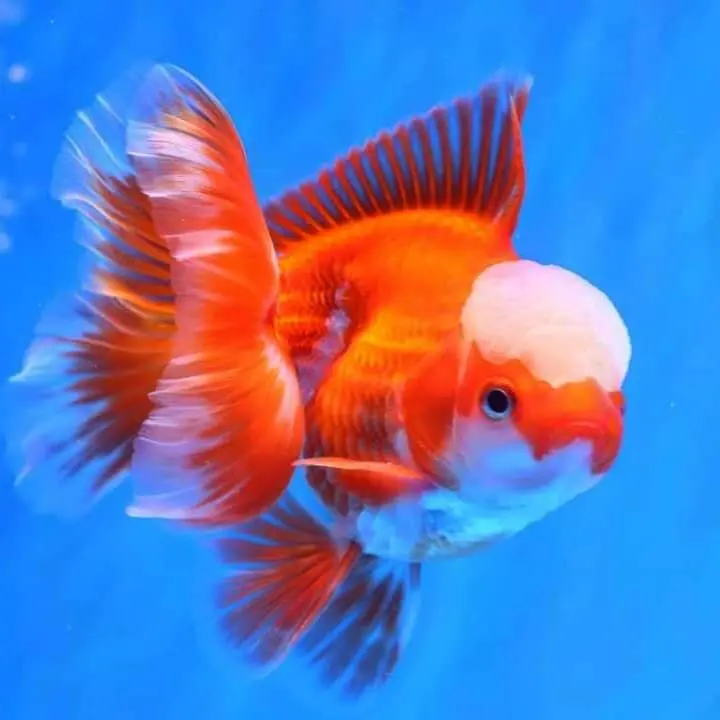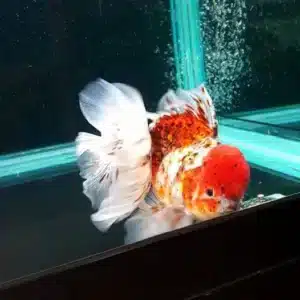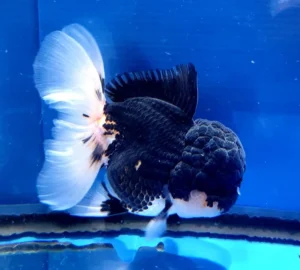The Oranda Goldfish is one of the most beloved and popular varieties among goldfish enthusiasts and is the Jewel of the Aquarium. Oranda Goldfish is a Goldfish with a big Head. Oranda Goldfish are known for their fleshy head growth, called a “wen” or “hood.” Oranda Goldfish – the big head goldfish is knon as the crown jewel in any aquarium. With its elegant, flowing fins and vibrant colors, this fish is as beautiful as it can get. Oranda goldfish is a fat goldfish that look chubby and beautiful.
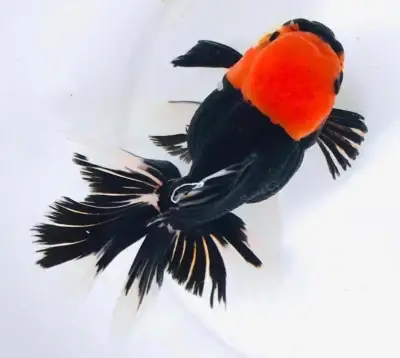
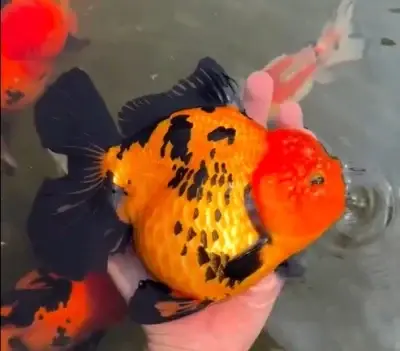
Types of Oranda Goldfish
1)White Oranda Goldfish
2)Black Oranda Goldfish
3)Calico Oranda Goldfish
4)Panda Oranda Goldfish
5)Red Cap Oranda Goldfish
Oranda Goldfish Lifespan- How long do Oranda Goldfish live?
Oranda goldfish can live for 15 years when provided with proper care. On an average, Oranda goldfish have a lifespan of 10 to 15 years. However, with exceptional care, some Orandas have been known to live for up to 20 years also. Oranda goldfish though a little vulnerable to and hard to keep than normal goldfish, with high water quality, providing a balanced diet, diesase free and a stress-free environment can contribute to their longevity. With my experience i can tell you that Oranda goldfish are not a hardy variety compared to the normal godlfish.
How Big Do Oranda Goldfish Get?
Oranda goldfish grows to a considerable size depending on its parental genetics , tank size, how often it is fed. On an average, an adult Oranda goldfish reaches a size of 8 to 12 inches in length including their long and flowing fins. In some cases, Orandas might grow even larger exceeding 12 inches in length if they have enough swimming space and are well fed with a quality food.
The growth rate of Oranda goldfish is influenced by their genetics, the size of their tank, the quality of their diet, and overall care. A spacious tank with ample swimming space and a well fed nutrient-rich diet will accelerate their growth and development.
Oranda Goldfish Tank Size
Oranda Goldfish would be cute and small when you first bring them home, but they grow large with round bodies that would need plenty of space. Unlike Normal goldfish, Orandas are slow swimmers and produce a lot of waste, which makes tank size very important for their health. They also need plenty of ventilation (oxygen exchange) and free space to swim around, because Orandas can get stressed easily in cramped, small and poorly ventilated tanks.
For a single Oranda Goldfish, you should plan for at least a 20 to 30 gallon (75–110 liters) tank. If you want to keep more than one, add an extra 10–15 gallons per fish. Bigger is always better, since it helps keep the water cleaner, improves oxygen levels, and gives your fish room to swim freely without feeling cramped for space.
Because Orandas can grow up to 8–12 inches (20–30 cm), small bowls or tiny tanks will quickly appear smaller and cramp for them. A spacious tank with a good filter not only supports their growth, but also reduces stress and helps them display their best colors and grow their flowing fins.
When setting up the tank, try to choose a longer, wider aquarium rather than a tall one. Orandas are bottom and mid-level swimmers, so they’ll make full use of the horizontal space. A wide tank also provides better oxygen exchange at the surface, which is vrey essential for Oranda goldfish.
In short, if you really want your Oranda to thrive, think of the tank as an investment in their long life. A larger setup with proper care will keep your Oranda Goldfish happy and healthy for many years.
Best substrate, plants, and decorations
Substrate: Use smooth, minute gravel or sand to avoid injury to their delicate fins and wen. Orandas enjoy foraging, so there is every chance that sand can enter the stomach. Nothing happens to Orandas when sand enters their stomach as they get excreted out. If you don’t find minute gravel then you can use large smooth and round gravel stones.
Plants and Decorations: Include live plants, natural eco-friendly decorations in the tank. Ensure that the decorations are not sharp and do not occupy too much space. Soft leaved plants like Java fern, Anubias are ideal. Decorations should have smooth edges to prevent tearing of their fins while the play around.
Oranda Goldfish Temperature
Keeping your Oranda Goldfish in the right environment is just as important as feeding them well. They thrive in stable water conditions, with an ideal temperature range of 69°F to 75°F (20–24°C). If you’re preparing them for breeding, you can gradually raise the temperature up to 82°F (28°C), but avoid sudden changes. Oranda goldfish don’t handle sudden temperature swings well.
Water Quality
Water quality is a key factor in their health. Oranda Goldfish eat a lot and produce a lot of waste, so a strong filtration system is essential. Check your water regularly(10 days) and aim for a pH between 7.0 and 7.5. To keep things stable, do a 25–30% water change every 10 days. Clean, well-oxygenated water not only prevents harmful ammonia and nitrate buildup, but also keeps them active and stress-free.
Oranda Goldfish Food & Diet
A balanced diet is one of the most important parts of caring for your Oranda Goldfish. Since they are slow swimmers with round fat bodies, they often lose out to faster fish while competing for food. That’s why feeding them the right way makes a big difference. Here are the kind of food they require-
-
High-quality sinking pellets: These should form major portion of their diet. Unlike floating pellets, sinking food sinks and reduces the risk of gulping air at the surface, which can lead to swim bladder problems.
-
Fresh vegetables(occasionlally): Oranda Goldfish benefit from vegetables like shelled peas, zucchini, spinach, and lettuce. These provide fiber and help with digestion, keeping their system running smoothly.
-
Protein treats (in moderation): Live or frozen foods such as brine shrimp, bloodworms, or daphnia are excellent occasional snacks. Think of these as “weekend treats” good for variety but not something to be feed every day.
Feed your Orandas 2–3 small meals per day only as much as they can finish in 5 minutes. Overfeeding them not only causes health issues but also dirties the water making the harder to maintain water quality. It’s better to underfeed slightly orandas than to overfeed them. A hungry Oranda will gulp lot of food and can develop digestion problems leading to sickness
Oranda Goldfish Tank Mates – Best and worst companions
Choosing the right tank mates is important for the well-being of Oranda Goldfish. Since Orandas are slower swimmers and gentle in nature, they should not be placed with fast or aggressive species.
Best tank mates for Oranda Goldfish:
-
Other fancy goldfish (Lionhead, Fantail, Ranchu).
-
Peaceful species that won’t nip fins.
Avoid these tank mates:
-
Fats moving fish, Comets .They eattoo fast, eat all the food.
-
Aggressive fish like Cichlids or Barbs they may nip the Oranda’s long fins and sometimes eat them.
Orandas are social, so they thrive in groups with other fancy goldfish that swim at a similar pace.
Common Health Issues in Oranda Goldfish
Despite their beauty, Oranda Goldfish are a bit more delicate than normal goldfish varieties because of their unique fat body shape and head growth. Knowing the common issues will help you catch the problems early:
Wen Care
The wen that makes Orandas so unique can also make them vulnerable. The wen can collect debris and is prone to bacterial or fungal infections. Look out for swelling, white patches, or discoloration.
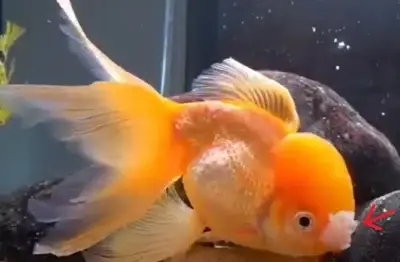
In rare cases, the wen may grow so large that it blocks the fish’s vision, making it harder for them to find food. In such situations, professional trimming by an experienced aquarist may be required.
Swim Bladder Problems
Because of their short, rounded bodies, Oranda Goldfish are more likely to suffer from swim bladder issues, which affect their balance and buoyancy. A fish with swim bladder problems may float on its side, struggle to dive, or hover awkwardly near the surface of the tank.
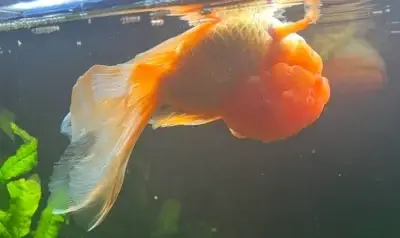
To reduce the risk:
-
Always use sinking pellets instead of floating ones.
-
ocasionally include fiber-rich vegetables like peas in their diet to improve digestion.
-
Avoid overfeeding, which can lead to digestive blockages.
Parasites & Stress
Oranda Goldfish are sensitive to stress. Poor water quality, overcrowding, or sudden changes in temperature can weaken their immune system, making them more vulnerable to parasites and disease. Always quarantine new fish before adding them to your main tank, and keep an eye on signs like flashing ,rubbing against objects, clamped fins and rapid gill movement.
Breeding Oranda Goldfish – step by step guide
Breeding Oranda Goldfish is both exciting and challenging. These fish don’t always breed as easily as the common goldfish. so patience and careful preparation is necessary. With the right setup and a little dedication, you can successfully raise a new generation which can be profitable also.
How to Tell Males VS Females in Oranda Goldfish
Before you set up a breeding tank, you’ll need to know which of your Orandas are male and which are female:
-
Males: When ready to spawn, males develop small white spots called breeding stars (tubercles) on their gill covers and pectoral fins. You may also notice them actively chasing females around the tank.
-
Females: Females appear rounder and fuller, especially in the belly area when carrying eggs. Their body shape is more plump compared to males. The region around the anus and the stomach appear much softer when applied pressure compared to male orandas. Being able to sex your fish correctly ensures you choose a healthy breeding pair.
Setting up the Breeding Tank
For best results, set up a separate breeding tank away from your main aquarium tank. A seperate tank gives you more control to keep the eggs safe from hungry adults.
-
Tank Size: Around 20–30 gallons is sufficient for a pair or small group.
-
Water Temperature: Slowly raise it to 72–82°F (22–28°C) to mimic spring — the natural trigger for spawning.
-
Substrate & Spawning Aids: Use a bare-bottom tank or smooth gravel for easy cleaning. Add spawning mops or fine-leaved plants where females can scatter their eggs.
-
Filtration: Use a gentle sponge filter. Strong currents may stress the fish or damage delicate eggs.
This setup reduces stress and makes it easier to collect and care for the eggs.
The Spawning Process
Spawning usually begins with an energetic courtship ritual that can last for several hours:
-
Courtship: The male Oranda goldfish chases the females, nudging her belly to stimulate egg release.
-
Egg Laying: The female Oranda scatters hundreds, sometimes thousands of eggs across plants, mops, or the tank bottom.
-
Fertilization: The male follows closely, releasing milt to fertilize the eggs.
-
After Spawning: Remove the adults immediately. Oranda goldfish offers no parental care and may eat the eggs if left in the tank.
Caring for Eggs and Fry
Once fertilized, the real work begins. The eggs and fry are very sensitive to water conditions and need consistent care. These are the procesess-
-
Incubation: The Eggs hatch in about 4 to 7 days, depending on water temperature. Keep water clean and provide light aeration with an air stone.
-
Preventing Fungus: A very few drops of methylene blue can help protect eggs from fungal infections.
-
Feeding Fry:
-
Days 1–3: Fry absorb their yolk sacs and don’t need food yet.
-
After Day 3: Start feeding with infusoria, liquid fry food, or baby brine shrimp.
-
As they grow: Gradually introduce finely crushed flakes and micro-pellets. Feed small amounts 3–4 times a day.
-
-
Tank Maintenance: Perform small, frequent water changes. Oranda fry are delicate and can be easily harmed by poor water quality.
Watching tiny fry grow, develop colors, and eventually show the characteristic Oranda wen is one of the most rewarding parts of fishkeeping.
Baby Oranda Goldfish – Care & Feeding
Baby Oranda Goldfish are delicate and require special attention during their first few months of life. Unlike adults, they are more vulnerable to changes in water quality and need a carefully planned diet to grow strong and healthy.
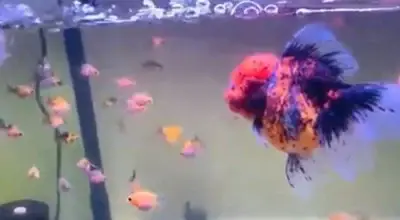
Tank Setup for Baby Orandas:
-
A smaller grow-out tank (10–20 gallons) with gentle filtration is ideal so the fry don’t get pulled into the filter.
-
Keep the water temperature stable between 72°F and 78°F to encourage steady growth.
-
Perform small, frequent water changes (10–15% every 2–3 days) to maintain water quality.
Feeding Baby Oranda Goldfish:
-
For the first few days after hatching, fry come out of live off their yolk sacs.
-
Once they start swimming, feed them with infusoria or baby brine shrimp.
-
After 2–3 weeks, gradually introduce crushed flakes or micro-pellets.
-
Feed small amounts 3–4 times a day.
Growth & Development:
-
Baby Oranda Goldfish begin to show their signature wen (head growth) at around 3–4 months.
-
Provide a balanced diet with protein (brine shrimp, daphnia) and vegetables (spinach, peas) to support both growth and wen development.
-
Separate the fastest growers if necessary, to prevent overcrowding and competition for food.
Caring for Baby Oranda Goldfish properly ensures they grow into healthy adults with vibrant colors and strong fins.
Oranda Goldfish for Sale – Buying Tips & Price Guide
If you’re searching for Oranda Goldfish for sale, prices vary based on variety, size, and quality.
-
Common Orandas: $20–$50
-
Special varieties (Panda, Black, White): $50–$150
-
Show-quality imports (Japan, Thailand): $200–$500+
Buying Tips:
-
Look for bright coloration and smooth swimming.
-
Inspect the wen for any redness, swelling, or damage.
-
Choose fish with flowing fins that aren’t torn.
-
Avoid lethargic or bottom-sitting fish.
Always buy from a reputable breeder or store to ensure you’re getting a healthy Oranda.
Oranda Goldfish – Frequently Asked Questions (FAQs)
1. How big do Oranda Goldfish get?
Oranda Goldfish can grow surprisingly large compared to other fancy goldfish. With good care, they typically reach 8–12 inches (20–30 cm) in length, and some may even get bigger in spacious ponds.
2. How long do Oranda Goldfish live?
With the right tank size, clean water, and a healthy diet, Oranda Goldfish can live 10–15 years on average. In outdoor ponds or with excellent care, some have been known to live 20 years or more.
3. What is the minimum tank size for Oranda Goldfish?
A single Oranda needs at least a 20–30 gallon (75–110 liters) tank, with an additional 10–15 gallons per extra fish. They grow large, produce a lot of waste, and need plenty of space to swim and breathe easily.
4. What temperature do Oranda Goldfish need?
They thrive in a stable temperature between 69–75°F (20–24°C). For breeding, the temperature can be gradually raised up to 82°F (28°C). Avoid sudden temperature changes, as Orandas stress easily.
5. What do Oranda Goldfish eat?
Oranda Goldfish are omnivores and need a balanced diet of-
-
High-quality sinking pellets (their main food)
-
Fresh vegetables like peas, zucchini, and spinach
-
Occasional protein treats such as brine shrimp or bloodworms
Feed them 2–3 small meals a day, giving only what they can finish in 2–3 minutes.
6. Why is my Oranda Goldfish floating or sinking oddly?
This is often due to swim bladder problems, which are common in fancy goldfish with rounded bodies. Causes include overfeeding, gulping air from floating food, or poor water quality. Feeding sinking pellets and adding vegetables like peas usually helps.
7. What is the “wen” on Oranda Goldfish?
The wen is the fleshy head growth that gives Orandas their signature “big head” look. It usually starts developing around 3–4 months of age and keeps growing as the fish matures. It’s harmless but can sometimes block vision or get infected if water quality is poor.
8. Can Oranda Goldfish live with other fish?
Yes, but only with peaceful, slow-moving tank mates. Other fancy goldfish varieties (like Ranchu, Lionhead, or Fantail) are the best companions. Avoid fast or aggressive fish that might outcompete Orandas for food.
9. Can Oranda Goldfish live in a bowl?
No — Orandas should never be kept in small bowls. They need a large, filtered aquarium to stay healthy. Bowls don’t provide enough space, oxygen, or stable water quality for these fish.
10. Do Oranda Goldfish need a heater?
Not always. Orandas are coldwater fish and can live without a heater in stable room temperatures. However, in cooler climates or during breeding, a heater may be necessary to keep the water within their ideal range.
11. How can I breed Oranda Goldfish?
Breeding requires a separate spawning tank with warmer water (72–82°F). Males develop breeding stars and chase females until eggs are scattered over plants or spawning mops. Adults should be removed after spawning to prevent them from eating the eggs. Fry hatch in 4–7 days.
12. Why is my Oranda’s head turning white or swollen?
This usually points to wen infections caused by bacteria or fungus. It can also happen if the wen is growing too fast. Maintain excellent water quality and seek vet or experienced aquarist advice if the infection spreads.
13. How many Oranda Goldfish can I keep together?
It depends on tank size. As a general rule:
-
20–30 gallons for the first fish
-
+10–15 gallons for each additional Oranda
Overcrowding causes stress, poor water quality, and disease.
14. Do Oranda Goldfish get along with plants?
Yes, but they may nibble nad eat softer and smaller leafed plants. Hardy plants like Java Fern, Anubias, or Hornwort work well. Many breeders also use artificial plants or spawning mops for safety.
15. Are Oranda Goldfish hard to care for?
They’re a bit more delicate than common goldfish because of their wen and body shape, but with the right tank, good diet, and regular water changes, they’re quite manageable. Beginners can care for them successfully if they follow basic goldfish-keeping rules.
White Oranda Goldfish
The White Oranda Goldfish is admired for its pure snow-white scales that shimmer under aquarium lights. With its elegant wen (head growth) and flowing fins, it carries an almost angelic presence in the tank.
Care Tips:
-
Lifespan: With proper care, they can live 10–15 years.
-
Tank: A minimum of 20 gallons is recommended, with stable water between 69–75°F (20–24°C).
-
Diet: Feed them sinking pellets as a staple, add leafy greens like spinach, and give occasional protein treats such as brine shrimp.
-
Health: Keep the water very clean to avoid common issues like wen infections or swim bladder problems.
-
Price: Typically ranges from $35–$125, depending on size and quality.
Black Oranda Goldfish
The Black Oranda Goldfish stands out with its deep, velvety black coloration that covers its body, fins, and wen. The striking contrast makes it one of the most dramatic and unique goldfish varieties.
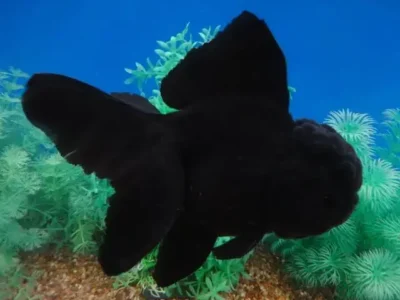
Care tips for Black Oranda Goldfish
-
Lifespan: 10–15 years with proper care.
-
Tank: Provide at least 20 gallons, with smooth substrate to protect delicate fins.
-
Diet: High-quality sinking pellets, peas for digestion, and occasional protein foods.
-
Health: Maintain excellent water quality — their dark color can sometimes hide signs of illness, so watch closely.
Price Range: $50–$150 depending on quality and location.
Calico Oranda Goldfish
The Calico Oranda Goldfish is known for its mosaic-like patchwork of orange, red, yellow, black, blue, and white. No two fish look alike, which makes this variety especially popular with collectors.
Caring for Calico Oranda Goldfish
-
Lifespan: 10–15 years, though some can live longer.
-
Tank: Needs at least 20–30 gallons due to their larger size (up to 12 inches).
-
Diet: Omnivorous — pellets, flakes, vegetables, and frozen/live foods. Feed small meals twice daily.
-
Health: Like other Orandas, prone to wen infections and buoyancy issues.
Price Range: $40–$120 depending on coloration and pattern uniqueness.
Panda Oranda Goldfish
The Panda Oranda Goldfish is beloved for its striking black-and-white markings, resembling the face of a panda bear. With long flowing fins and a two-tone wen, it’s a favorite among aquarists.
Caring for Panda Oranda Goldfish
-
Lifespan: Around 10–12 years with good care.
-
Tank: Start with 20 gallons for one, with an extra 10 gallons per additional fish.
-
Diet: Balanced diet of sinking pellets, blanched veggies, and occasional frozen treats.
-
Health: Sensitive to poor water conditions — weekly 25–30% water changes are a must.
Price Range: $50–$150, depending on size, color balance, and breeder.
Red Cap Oranda Goldfish
The Red Cap Oranda Goldfish is perhaps the most iconic variety, with its bright red wen contrasting against a pure white body. Its flowing fins and “crown-like” head growth make it one of the most elegant and sought-after fancy goldfish.
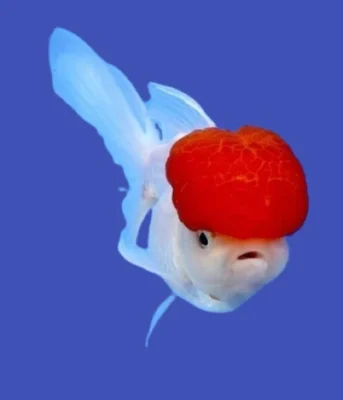
Caring for Red Cap Oranda Goldfish
-
Lifespan: 10–15 years on average.
-
Tank: Minimum 20 gallons, clean water with gentle filtration.
-
Diet: Goldfish pellets, leafy greens, and protein snacks like bloodworms in moderation.
-
Health: Prone to swim bladder issues; feed sinking pellets instead of floating foods.
Price Range: $25–$125 depending on quality, size, and import source.

